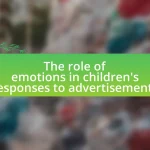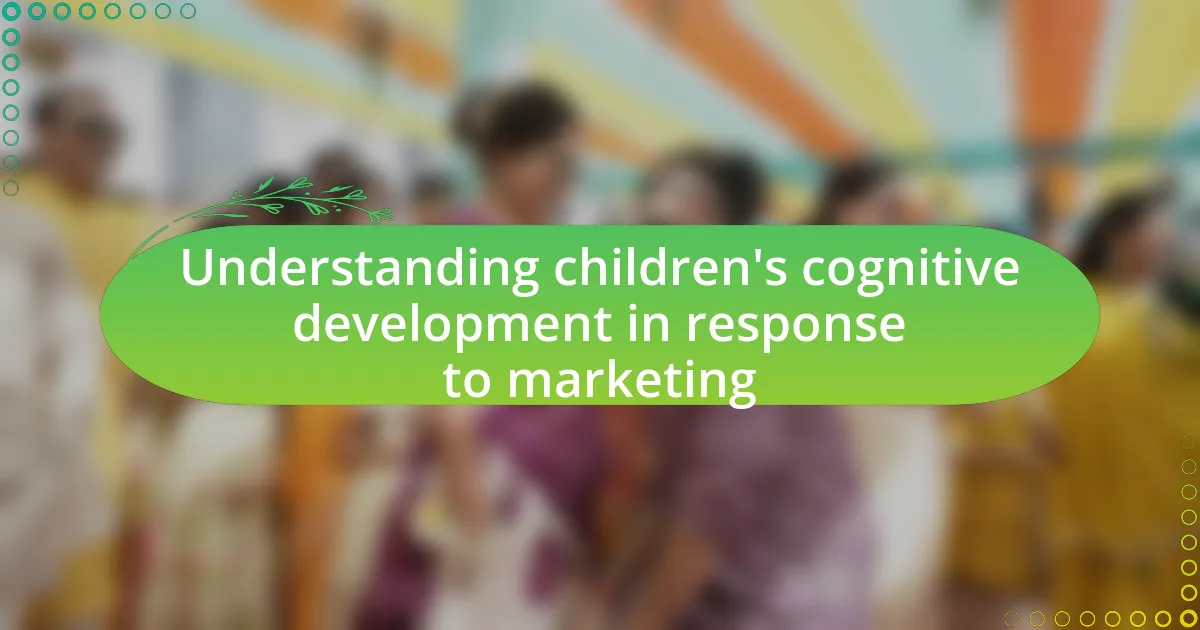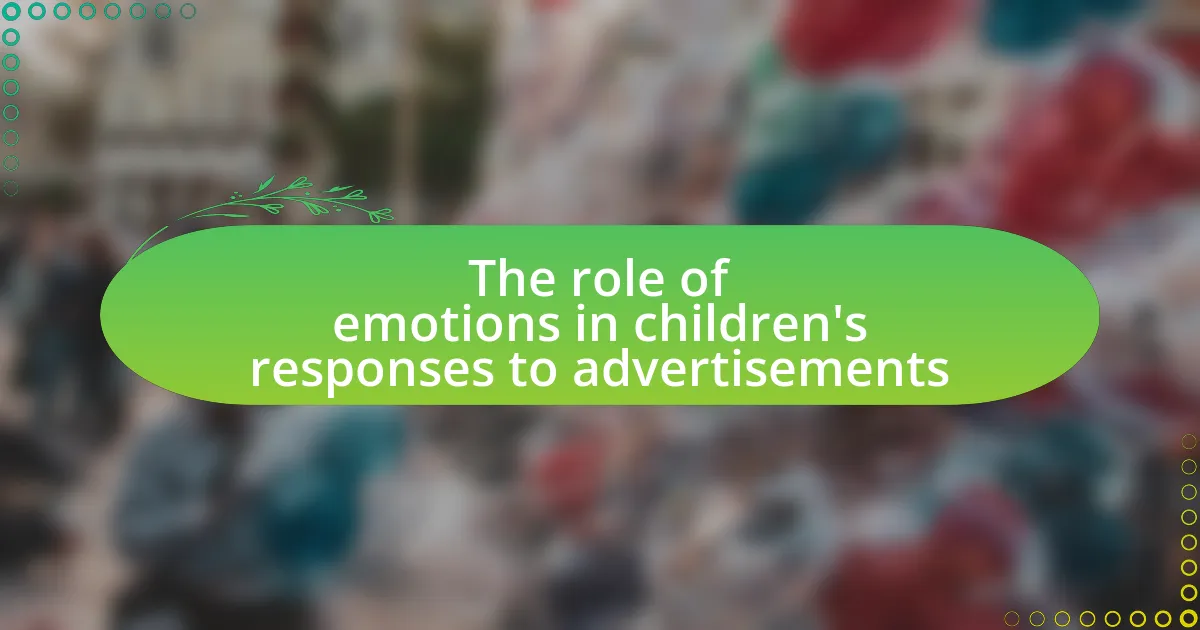The article examines the critical role of education in enabling children to evaluate advertisements effectively. It highlights how structured curricula and media literacy programs equip children with analytical skills to identify persuasive techniques, recognize bias, and assess the credibility of advertising content. Key concepts such as the purpose of ads, emotional appeals, and the distinction between needs and wants are discussed, along with the impact of cognitive development on children’s ability to analyze ads. The article also addresses the challenges educators face, the influence of external factors like parental attitudes and peer pressure, and practical strategies for enhancing children’s ad evaluation skills through engaging lesson plans and resources.

What is the role of education in helping children critically evaluate ads?
Education plays a crucial role in helping children critically evaluate advertisements by equipping them with analytical skills and media literacy. Through structured curricula, children learn to identify persuasive techniques, recognize bias, and assess the credibility of sources. Research indicates that media literacy programs can significantly enhance children’s ability to discern advertising strategies, leading to more informed consumer choices. For instance, a study published in the Journal of Advertising Research found that students who participated in media literacy education demonstrated a 30% improvement in their ability to critically analyze ads compared to those who did not receive such training. This evidence underscores the importance of education in fostering critical thinking skills necessary for evaluating advertisements effectively.
How does education influence children’s understanding of advertisements?
Education significantly enhances children’s understanding of advertisements by equipping them with critical thinking skills and media literacy. Through structured learning, children learn to analyze the persuasive techniques used in ads, such as emotional appeals and misleading information. Research indicates that children who receive media literacy education are better at identifying advertising strategies and understanding the intent behind them. For instance, a study published in the Journal of Advertising Research found that media literacy programs improved children’s ability to discern between entertainment and advertising content, leading to more informed consumer behavior. This educational foundation empowers children to question and evaluate the messages they encounter in advertisements, fostering a more discerning approach to media consumption.
What key concepts should children learn about advertising?
Children should learn key concepts about advertising, including the purpose of ads, persuasive techniques, target audiences, and the distinction between needs and wants. Understanding the purpose of ads helps children recognize that advertisements aim to sell products or services. Learning about persuasive techniques, such as emotional appeals and celebrity endorsements, enables children to identify how ads influence their decisions. Recognizing target audiences teaches children that ads are designed for specific groups, which can affect how messages are crafted. Finally, distinguishing between needs and wants empowers children to make informed choices about their purchases, fostering critical thinking skills essential for evaluating advertisements effectively.
How do children’s cognitive abilities affect their evaluation of ads?
Children’s cognitive abilities significantly influence their evaluation of advertisements by determining their understanding of persuasive techniques and the ability to discern between entertainment and marketing. Younger children, typically under the age of 8, often struggle to recognize the intent behind ads, viewing them as mere entertainment rather than promotional content. Research indicates that children develop critical thinking skills around the age of 8, which enhances their ability to analyze and question the messages presented in advertisements. For instance, a study by the American Psychological Association found that children aged 8 and older are more likely to understand the persuasive nature of ads and can identify exaggerations or misleading claims. This cognitive development allows them to evaluate ads more critically, leading to more informed consumer choices.
Why is critical evaluation of ads important for children?
Critical evaluation of ads is important for children because it equips them with the skills to discern persuasive techniques and identify misleading information. By developing critical thinking skills, children can better understand the intent behind advertisements, which often aim to manipulate emotions and influence purchasing decisions. Research indicates that children are particularly vulnerable to advertising tactics, as they may not fully grasp the distinction between entertainment and marketing. For instance, a study published in the Journal of Consumer Research found that children aged 8 to 12 are less likely to recognize persuasive intent in ads compared to older adolescents and adults. This highlights the necessity of education in fostering critical evaluation skills, enabling children to make informed choices and resist undue influence from advertising.
What are the potential impacts of uncritical acceptance of advertisements?
Uncritical acceptance of advertisements can lead to misinformation and consumer manipulation. When individuals accept advertisements without skepticism, they may be misled about product efficacy, resulting in poor purchasing decisions. For instance, studies show that children are particularly vulnerable to advertising tactics, often failing to distinguish between entertainment and marketing, which can lead to unhealthy consumption patterns. Research by the American Psychological Association indicates that exposure to misleading advertisements can contribute to increased materialism and lower self-esteem among children. This highlights the necessity for educational interventions that equip children with critical thinking skills to evaluate advertisements effectively.
How can critical evaluation skills protect children from misleading ads?
Critical evaluation skills protect children from misleading ads by enabling them to analyze and question the information presented in advertisements. These skills help children discern between factual claims and persuasive techniques, allowing them to identify exaggerations or deceptive practices commonly used in marketing. Research indicates that children who receive education on media literacy are better equipped to recognize misleading content; for instance, a study by the American Academy of Pediatrics found that media literacy programs significantly improved children’s ability to critically assess advertisements. This educational approach fosters skepticism and informed decision-making, ultimately reducing the likelihood of children being influenced by misleading ads.

What methods can educators use to teach critical evaluation of ads?
Educators can use methods such as media literacy programs, critical discussions, and hands-on activities to teach critical evaluation of ads. Media literacy programs provide structured lessons that focus on understanding advertising techniques, persuasive language, and target audiences, which helps students analyze ads critically. Critical discussions encourage students to share their thoughts on various advertisements, fostering a collaborative environment where they can question and evaluate the effectiveness and ethics of the ads presented. Hands-on activities, such as creating their own advertisements or analyzing real-world examples, allow students to apply their knowledge practically, reinforcing their ability to discern the intent and impact of advertising. These methods are supported by research indicating that media literacy education significantly enhances students’ critical thinking skills regarding advertisements.
How can media literacy programs enhance children’s ad evaluation skills?
Media literacy programs enhance children’s ad evaluation skills by teaching them to critically analyze advertising content and recognize persuasive techniques. These programs provide children with the tools to identify biases, understand the intent behind advertisements, and assess the credibility of the information presented. Research indicates that children who participate in media literacy education demonstrate improved critical thinking skills and are better equipped to discern between factual information and marketing strategies. For instance, a study by the Center for Media Literacy found that students exposed to media literacy curricula showed a 30% increase in their ability to evaluate advertisements effectively compared to those who did not receive such training.
What are the essential components of an effective media literacy curriculum?
An effective media literacy curriculum includes critical thinking skills, understanding media messages, and the ability to analyze and evaluate advertisements. Critical thinking skills enable students to question the intent and credibility of media content. Understanding media messages involves recognizing how advertisements are constructed to influence perceptions and behaviors. The ability to analyze and evaluate advertisements equips students with tools to discern bias, identify persuasive techniques, and assess the impact of media on society. Research indicates that curricula incorporating these components significantly enhance students’ media literacy, fostering informed consumers who can navigate the complexities of advertising.
How can hands-on activities improve children’s understanding of ads?
Hands-on activities can significantly enhance children’s understanding of ads by allowing them to engage directly with the concepts being presented. Through interactive experiences, children can analyze the persuasive techniques used in advertisements, such as emotional appeals and visual imagery, which fosters critical thinking. Research indicates that experiential learning, such as creating their own ads or participating in role-playing scenarios, helps children grasp the intent behind marketing strategies. For instance, a study published in the Journal of Advertising Education found that students who participated in hands-on projects demonstrated a deeper comprehension of advertising principles compared to those who only received traditional instruction. This active involvement not only reinforces theoretical knowledge but also equips children with the skills to critically evaluate the ads they encounter in everyday life.
What role do discussions and debates play in teaching ad evaluation?
Discussions and debates play a crucial role in teaching ad evaluation by fostering critical thinking and analytical skills among students. Engaging in discussions allows students to articulate their thoughts, question assumptions, and explore different perspectives on advertisements. This interactive process enhances their ability to assess the persuasive techniques used in ads, such as emotional appeals and misleading information. Research indicates that students who participate in debates demonstrate improved reasoning skills and a deeper understanding of media literacy concepts, which are essential for evaluating advertisements effectively.
How can educators facilitate meaningful discussions about advertisements?
Educators can facilitate meaningful discussions about advertisements by encouraging critical thinking and analysis of ad content. This can be achieved through structured activities such as analyzing the persuasive techniques used in various advertisements, discussing the target audience, and exploring the impact of advertisements on consumer behavior. Research indicates that when students engage in discussions that dissect the elements of advertisements, such as emotional appeal and factual claims, they develop a deeper understanding of media literacy. For instance, a study by the American Academy of Pediatrics highlights that media literacy education can significantly enhance children’s ability to critically evaluate advertisements, leading to more informed consumer choices.
What strategies can be used to encourage critical thinking during debates?
Encouraging critical thinking during debates can be achieved through strategies such as fostering an environment of open dialogue, teaching argument analysis, and promoting the use of evidence-based reasoning. Open dialogue allows participants to express diverse viewpoints, which enhances understanding and critical evaluation of different perspectives. Teaching argument analysis equips debaters with the skills to dissect arguments, identify logical fallacies, and assess the strength of evidence presented. Promoting evidence-based reasoning encourages participants to support their claims with credible sources, which is essential for substantiating arguments and developing informed opinions. These strategies collectively enhance critical thinking skills, enabling individuals to engage more thoughtfully in debates.

What challenges do educators face in teaching children about ads?
Educators face significant challenges in teaching children about ads, primarily due to the complexity of advertising techniques and the cognitive development stages of children. Children often lack the critical thinking skills necessary to analyze persuasive messages, making it difficult for educators to convey the nuances of advertising strategies effectively. Additionally, the pervasive nature of advertisements in various media can overwhelm children, leading to confusion about the intent behind ads. Research indicates that children under the age of eight are particularly susceptible to believing that advertisements are truthful, which complicates educators’ efforts to instill skepticism and critical evaluation skills. Furthermore, educators may struggle with limited resources and training on how to effectively teach media literacy, which is essential for helping children navigate the advertising landscape.
How do children’s developmental stages affect their ability to evaluate ads?
Children’s developmental stages significantly influence their ability to evaluate advertisements. Younger children, particularly those in the preoperational stage (ages 2-7), often struggle to distinguish between reality and fantasy, making them more susceptible to persuasive advertising techniques. As children progress into the concrete operational stage (ages 7-11), they begin to develop critical thinking skills, allowing them to analyze ads more effectively, but they may still lack the experience to fully understand marketing strategies. By the time children reach the formal operational stage (ages 12 and up), they can engage in abstract thinking and are better equipped to critically assess advertisements, recognizing persuasive intent and evaluating the credibility of claims. Research indicates that education plays a crucial role in enhancing these evaluative skills, as children exposed to media literacy programs demonstrate improved abilities to analyze and critique advertisements.
What age-related factors should educators consider when teaching about ads?
Educators should consider cognitive development, media literacy skills, and emotional maturity as key age-related factors when teaching about ads. Cognitive development varies significantly across age groups, influencing how children understand persuasive techniques; for instance, younger children may struggle to differentiate between entertainment and advertising, while older students can analyze and critique ad strategies. Media literacy skills are essential, as children’s ability to critically evaluate ads improves with age and experience, making it crucial for educators to tailor lessons accordingly. Emotional maturity also plays a role, as younger children may be more susceptible to emotional appeals in advertising, necessitating age-appropriate discussions about manipulation and intent. These factors highlight the importance of adapting educational approaches to align with students’ developmental stages, ensuring effective learning outcomes.
How can educators adapt their approaches for different age groups?
Educators can adapt their approaches for different age groups by tailoring content complexity, engagement strategies, and assessment methods to align with developmental stages. For younger children, educators should use simple language, visual aids, and interactive activities to foster understanding and engagement. For example, using storytelling and games can help preschoolers grasp basic concepts about advertisements. As children grow, educators can introduce more complex discussions and critical thinking exercises, such as analyzing the persuasive techniques used in ads, which is suitable for middle school students. Research indicates that age-appropriate strategies enhance learning outcomes; for instance, a study by the National Association for Media Literacy Education highlights that children aged 8-12 benefit from hands-on activities that promote media literacy skills. Thus, adapting teaching methods according to age ensures that educational content is both accessible and effective in helping children critically evaluate advertisements.
What external influences can hinder children’s critical evaluation of ads?
External influences that can hinder children’s critical evaluation of ads include parental attitudes, peer pressure, and media exposure. Parental attitudes towards advertising can shape children’s perceptions; for instance, if parents express skepticism about ads, children are more likely to adopt a critical stance. Conversely, if parents are indifferent or supportive of advertising, children may not develop the necessary skills to evaluate ads critically. Peer pressure also plays a significant role, as children may feel compelled to conform to their friends’ opinions about products, which can overshadow their ability to analyze advertisements independently. Additionally, excessive media exposure, particularly to persuasive advertising techniques, can desensitize children and impair their critical thinking skills, making them more susceptible to manipulation. Research indicates that children exposed to high levels of advertising are less likely to question the credibility of the messages presented, reinforcing the need for educational interventions to enhance their critical evaluation skills.
How do peer pressure and social media impact children’s perceptions of ads?
Peer pressure and social media significantly shape children’s perceptions of advertisements by creating a desire for conformity and influencing their preferences. Children often feel compelled to align their choices with those of their peers, which can lead to a heightened susceptibility to advertising messages that promote popular trends or products endorsed by influencers on social media platforms. Research indicates that 70% of adolescents are influenced by peer opinions when making purchasing decisions, highlighting the strong connection between social validation and consumer behavior. Furthermore, social media exposes children to targeted ads that leverage their social circles, making them more likely to trust and engage with brands that their friends endorse. This combination of peer influence and social media exposure can distort children’s understanding of advertising, making them more likely to accept promotional content as authentic and desirable.
What role do parents play in shaping children’s attitudes towards advertising?
Parents play a crucial role in shaping children’s attitudes towards advertising by influencing their understanding and interpretation of marketing messages. Through discussions about advertisements, parents can help children develop critical thinking skills, enabling them to analyze the intent behind ads and recognize persuasive techniques. Research indicates that children whose parents engage them in conversations about advertising are more likely to question the credibility of ads and understand the difference between entertainment and marketing. For instance, a study published in the Journal of Advertising Research found that parental guidance significantly enhances children’s ability to discern advertising tactics, leading to healthier consumer habits as they grow older.
What practical tips can educators use to enhance children’s ad evaluation skills?
Educators can enhance children’s ad evaluation skills by incorporating critical thinking exercises into their curriculum. These exercises can include analyzing various advertisements for persuasive techniques, such as emotional appeals, celebrity endorsements, and misleading information. Research indicates that children who engage in discussions about the intent and impact of ads develop stronger analytical skills, as shown in a study by the American Psychological Association, which found that critical media literacy programs significantly improve students’ ability to discern advertising strategies. Additionally, educators can encourage students to create their own advertisements, fostering an understanding of the techniques used in marketing and promoting critical reflection on the messages conveyed.
How can educators create engaging lesson plans focused on advertising analysis?
Educators can create engaging lesson plans focused on advertising analysis by incorporating real-world advertisements and interactive activities that encourage critical thinking. For instance, using current ads from various media allows students to analyze persuasive techniques, target audiences, and the effectiveness of messaging. Research indicates that hands-on activities, such as group discussions and presentations, enhance student engagement and understanding of advertising strategies. By integrating multimedia resources and encouraging students to create their own advertisements, educators can foster creativity while reinforcing analytical skills. This approach aligns with educational standards that emphasize critical evaluation and media literacy, making the lessons relevant and impactful.
What resources are available for teaching children about ads effectively?
Resources available for teaching children about ads effectively include educational websites, interactive games, and lesson plans specifically designed for media literacy. Websites like Common Sense Media provide comprehensive guides and resources that help educators teach children how to analyze advertisements critically. Interactive games, such as “Admongo,” engage children in identifying persuasive techniques used in ads, enhancing their understanding of marketing strategies. Additionally, lesson plans from organizations like the Center for Media Literacy offer structured activities that promote critical thinking about media messages. These resources are validated by research indicating that media literacy education can significantly improve children’s ability to evaluate advertisements critically.






